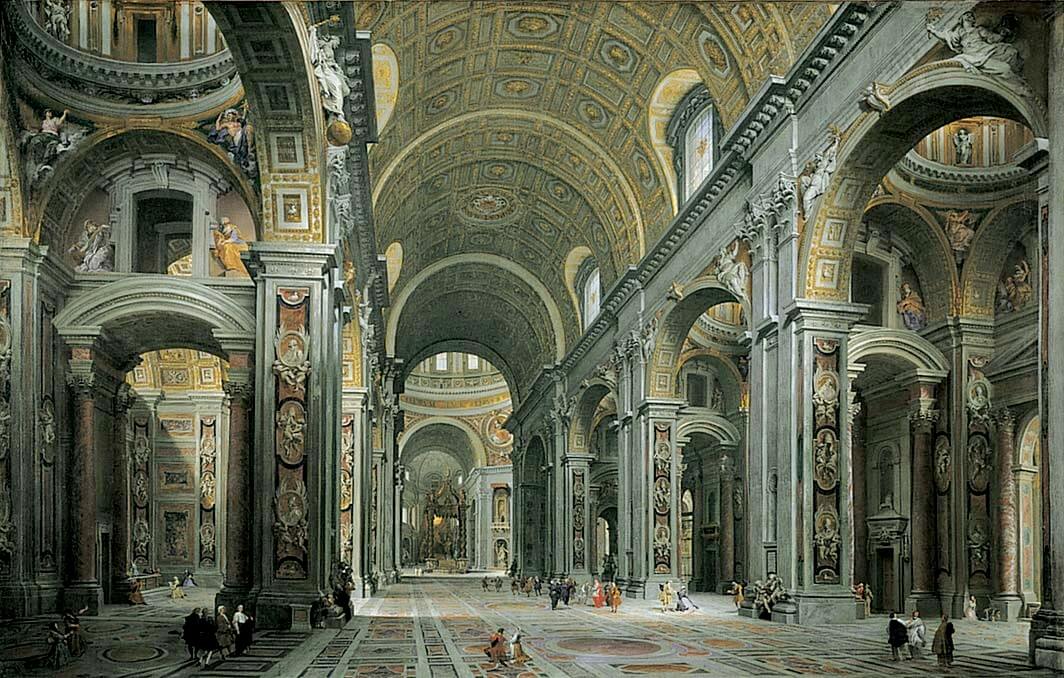Above: nave of St. Peter’s Basilica in Rome as painted by Panini, 1731.
The glorious feast of St Peter and Paul is upon us and turns our thoughts to the Eternal City. O Rome, where all roads lead, how much art have you inspired? How much holiness? How much anguish? Hallowed walls where saints and sinners have walked and talked and governed the Church and the destinies of so many lives!
Unsurprisingly, the holy apostles we celebrate have inspired Catholic music for centuries. The communion for their feast is taken from Matthew 18:
Thou art Peter,
And upon this Rock I will build My Church:
and the gates of hell shall not overcome it.
And I will give thee the keys to the kingdom of heaven.
The brief Gregorian chant is wonderfully lilting and memorable. Barely 30 seconds long, it is a joy to sing with verse after verse of the psalms. But what of the great composers who have taken this text as their inspiration? Here are three different settings that I find quite beautiful.
In the late 1500’s Palestrina tried his hand at setting it for six voices. The result? Exactly what you might expect from the prince of polyphonists: breathtaking. Try listening to the rendition by New York Polyphony.
Alternating between the higher and lower three voices, Palestrina is able to create a double choir effect. As with a number of his motets, it comes in two parts, the first of which is often performed by itself. Here is a performance which includes the second half as well. Unsurprisingly, Palestrina’s Iberian counterpart, Tomás Luis de Victoria, also has a six voice setting of this text. The resemblances are remarkable!
Much less well known than Palestrina, Mikołaj Zieleński, the first Polish composer of the baroque era about whose life almost nothing is known, has also set this communion text. In this recording, the composition, originally for two four part choirs, is performed by a bass and soprano ornamenting their lines, with an organ reduction of the other parts. The effect is intimate and delicate as the warm voice of the bass meshes with the cooler tone of the female singer against the velvet-soft background of the flute stop of the organ.
In modern times, Sir James MacMillan’s earth-shattering setting of the text is made even more moving by its being written for the visit of Pope Benedict XVI.
MacMillan wrote of it: “As an ex-brass player myself, who loves writing for voices, it was very exciting to be invited to combine the two sounds with percussion and organ in Tu es Petrus… It was with immense pride that I wrote this work for the visit of His Holiness Pope Benedict XVI to the Cathedral… The piece is noisy enough as it stands, and I remember being taken aback at the rehearsal when the tumult filled the Cathedral.”
While we might be tempted to complain that the Rome of today no longer inspires such liturgical music, the contemplation of such motets as these reminds us that the gates of hell have often seemed like they were on the verge of prevailing but didn’t: the midst of the Reformation which eventually inspired the counter-reformation music of Palestrina’s era must have seemed dark at the time; the baroque decadence which was nonetheless countered by a proliferation of saints in all parts of the world must have been discouraging; in our own day, the ascendance of Pope Benedict to the throne of St Peter gave a new impetus and life to traditional Catholicism and the arts. The night is always darkest before the dawn; holy Apostles Peter and Paul, intercede for us to God that the darkness which at times affects the holy city today be lifted through your intercession, and a new light of faith and artistic inspiration dawn on us all.


